The Flexshooter Pro and Flexshooter Mini are uniquely designed tripod heads with a double-ball system combining horizon leveling and a classic ball head with a 2-way pan and tilt mechanism perfect for super-telephoto lenses. The Flexshooter ball heads also include a sprung counterbalance system that delivers a weightless feeling to your lens, allowing you to move it quickly when needed but keep it in place when you take a hand off your camera. These are gimbal-like features in a much smaller, lighter package. So, how well does it work?
In this review, we will take a detailed look at the design and function of the Flexshooter tripod heads to determine their pros and cons compared to other tripod head types, such as ball heads, gimbals, and 2-way tilt heads. While we will concentrate on the most popular Flexshooter Pro and Flexshooter Mini models I have tested exhaustively worldwide, some thoughts on the Flexshooter Extreme are also included.
Long-term update: I published this review some years ago, but I recently noticed myself choosing the Flexshooter heads from my gear closet more often. For this reason, I decided to go back and make a few updates to this article. Some changes were simple tweaks to tidy things up, while others speak to the changes in my routine and how they parallel my recent lens choices in a changing industry offering much lighter super-telephoto lenses. My conclusion has not changed, but my continued experience with the products adds more to the story.
Disclaimer: Flexshooter provided me with their heads for testing and review. No money changed hands, and they were not permitted to see the review before it was published. I may make a small commission if you purchase one of these heads through the links on this page.
Table of Contents
Flexshooter Sizes
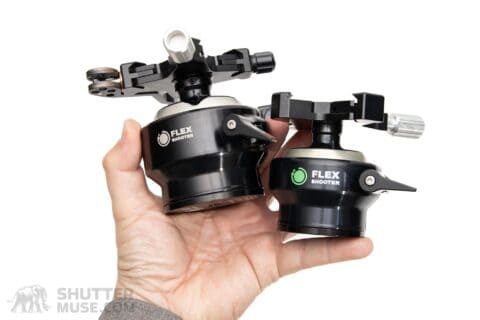

The Flexshooter has three primary variations: Flexshooter Mini, Flexshooter Pro, and Flexshooter Extreme. Flexshooter Pro and Mini are available with either a screw-know clamp or a lever-release clamp, while the oversized Extreme version is only available with a screw-knob clamp. Flexshooter Pro and Flexshooter Mini are available in black or black and silver, whereas Flexshooter Extreme is only available in black and silver.
How do the colors vary? The main body and the clamp are black on all versions of these tripod heads. The only difference between the “black” and “black and silver” versions of the Flexshooter Pro and Mini is that the internal leveling ball is also black. Why opt for the all-black version? Theoretically, they are very slightly more stealthy. It’s marginal, though. And if the black version were unavailable, I wouldn’t stress too much about ordering the black and silver. I have used the black and silver versions for a few years, and I can’t say there have been any issues. After all, most ball heads have a silver ball.
Flexshooter Specifications
| Spec | Mini | Pro | Extreme |
|---|---|---|---|
| Weight | 0.97 lb / 440 g | 1.5 lb / 680 g | 2.53 lb / 1150 g |
| Load Capacity | 21 lb / 9.53 kg | 100 lb / 45.36 kg | 132.28 lb / 60 kg |
| Ball Sphere Diameter | 2.17″ / 55 mm | 2.60″ / 66 mm | 3.23″ / 82 mm |
| Centre Sphere Diameter | 1.37″ / 35 mm | 1.8″ / 45 mm | 2.3″ / 58 mm |
| Price | $Check | $Check | $Check |
Flexshooter Clamp Options

The Flexshooter Pro and Flexshooter Mini are available with either a screw-knob or a lever-release clamp. Flexshooter’s clamps are Acra Swiss compatible and unique in that you can mount an Arca plate parallel or perpendicular to the tilt direction. It’s an ingenious solution, allowing you to quickly switch between an Arca foot on a lens running fore and aft and an Arca plate on a camera body that runs left to right across the clamp. As long as you take note of the etched “Lens Direction” arrow on the clamp, the camera’s tilt axis will be lined up with the lens.
The option to spec a Flexshooter ball head with a lever-release clamp comes at a relatively steep $100 premium over the screw-lock version. Truthfully, I’m unsure why the price varies this much, and it’ll probably give some people pause for thought. Should you opt for the easier-to-use lever-release version or save $100? You can’t buy the clamps individually, so this is a long-term decision.
If you’re buying the Flexshooter Pro to use it with a larger super-telephoto lens like a 600mm f/4 or 400mm f/2.8, I’d recommend spending the extra money on the lever-release clamp. Operating any quick-release ball head clamp with one hand means holding and stabilizing your camera and lens with a single hand for a brief moment. Whatever your age or strength, there will be moments when this takes some exertion with a heavy setup. A lever-release clamp speeds up the process and might lessen disaster opportunities. This isn’t a Flexshooter-only question. The same choice must be made for any tripod head.
The clamp choice isn’t as simple if you plan to use a lighter-weight telephoto lens on a Flexshooter Mini. My Mini has a screw-lock clamp, and while I would prefer it to have a lever-release clamp, I have not had any real issues with the screw version. If the overall price of the Flexshooter is already pushing the limits of your budget, the screw-lock is fine on the Flexshooter Mini. Opt for the lever-release if you want an overall easier experience and money isn’t an issue.
Worth mentioning is the lever clamp’s clamp tension adjustment knob, seen above. Arca-Swiss plates from different manufacturers are machined to different tolerances. The small adjustment knob allows you to tweak the clamping force applied when the lever lock is closed to allow for these small variations in Arca plate width. If you only ever mount one lens foot in the clamp, you’ll only need to adjust this the first time you use it.
Flexshooter Design and Features
To understand the features of the Flexshooter better, it’s best to walk step-by-step through how you would use it in the field: Once your tripod is set in place, release the large black locking knob. This loosens the outer ball. Use the bubble level on the outer ball to level the camera by getting the bubble dead center in the bullseye. With the camera leveled using the outer ball, lock it down by tightening the black locking knob.

Now loosen the silver knob on the left side of the Arca clamp. This loosens the sprung counterbalance system inside the secondary ball and allows you to tilt the camera forward or backward and pan it 360 degrees. Significantly, this secondary ball can only move in those two axis. It will not “flop” to the side like the ball on a regular ball head. At this point, the secondary ball is acting like a 2-way tilt head with a 360-degree panning base, but with one important addition.
When you have dialed in the correct amount of counterbalance on the silver knob, you can take your hands off your camera and have it stay perfectly still, even though it is not locked. The system works similarly to many video fluid heads. Balancing the camera in the Arca clamp and adjusting the counterbalance tension is quick and intuitive. Once you’ve done it a couple of times, you get a good feel for it, and the process becomes second nature. The benefit? Like a well-balanced gimbal head, the Flexshooter leaves your camera in a “ready to go” state. When the action happens, there is nothing to. unlock. Just gram the camera and swing it round onto your subject.
The only thing that takes a little getting used to is the need to tighten the counterbalance knob before moving your tripod to the next location. While the camera will remain still and balanced in your shooting position, if you pick the legs up and sling them over your shoulder without locking the counterbalance knob, you’ll feel the camera tilt to an awkward angle. This doesn’t put your gear in danger, but best practice is to lock all the knobs before moving the tripod around with a camera on it.
You should be aware that when the outer ball is leveled, the inner ball provides slightly less upward and downward tilt than you may be used to with a gimbal head. The photos above show this limitation. I rarely need to shoot at more extreme angles, but if needed, you can either tilt the tripod back slightly (keeping a careful hand on it) or tilt the outer ball forward or backward. If you do this, the camera will not be level while panning, but how often are you tilting up and down to the extreme while panning?
This slight shortcoming has yet to be an issue in real-world use for my shooting style. Further upward tilt is also available if you align the tilt with the drop notch on the outer ball.
This step-by-step instruction has covered using the Flexshooter with a super-telephoto lens, but what about wide-angle lenses for landscape work? This scenario can be somewhat simpler as you can tighten the counterbalance knob (silver knob) and use the large black knob just as you would with any other ball head. Your camera will have a full range of motion, and there’s a 90-degree drop-notch on one side to switch to a portrait orientation if you aren’t using an L bracket. It really is no different than using any other ball head.
Also, you can use the outer ball to level the camera and the inner ball to adjust your framing for panoramic photography. There’s no need to carry a dedicated panning clamp and leveling base to get perfectly stitched panoramas with a nodal slide.

Flexshooter Vs a Gimbal Head
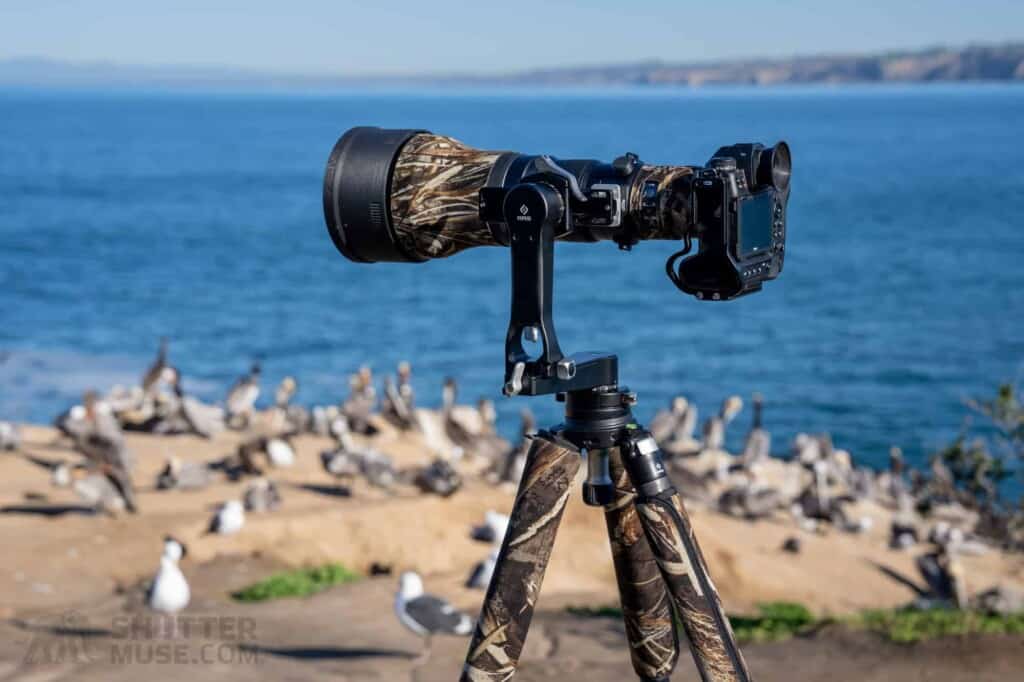
A Flexshooter is not a gimbal head. Although a Flexshooter and a gimbal head both allow you to smoothly pan and tilt a super-telephoto lens with almost no effort, they achieve this in very different ways. When correctly adjusted, a gimbal head is perfectly balanced in the up/down and fore/aft directions so that rotation occurs around the center of gravity of your camera+lens combination. When you can take a hand off your camera, the lens will not move. Furthermore, putting a hand on the camera and tilting or panning the lens will feel weightless.
Correctly setting up a gimbal requires you to slide the lens back and forth on the clamp to find the fore/aft balance point. Then, if you are using a cradle-style clamp, you will raise and lower the clamp to find the vertical balance point that prevents the lens from recentering when you take your hand off the camera. On the other hand, the Flexshooter uses a spring-loaded counterbalance within the head to counteract the camera’s weight. When you drop the lens into the Flexshooter’s clamp, you adjust the counterbalance tension with a knob to prevent it tipping forward or backwards when you take a hand off your camera.
Once balanced, the Flexshooter has more resistance than most gimbal heads but still allows you to pan and tilt the lens relatively smoothly. A Flexshooter is lighter than most gimbal heads and considerably more compact for travel. It’s also important to consider that many gimbal users prefer to use a gimbal with a tripod leveling head to ensure a level horizon when panning. With a Flexshooter, the leveling component is built into the head – no additional leveling head is required, further increasing the weight difference between the two options.
While a gimbal head can be used with wide-angle lenses for landscape photos if your camera is paired with the proper adapter plates to switch the clamp direction, this adds more weight to your kit, and some find it a cumbersome way to shoot. On the other hand, a Flexshooter head can be used just like a regular ball head, giving it far more flexibility than a gimbal head.
Is a Flexshooter Better Than a Gimbal for Wildlife Photography?
I have used the Flexshooter for wildlife photography alongside various gimbal heads while creating reviews for this website. Both types of heads can achieve the same thing. I have never found myself in a situation where one choice or another prevented me from getting a particular photo. In other words, it’s hard to go wrong with this choice. That said, you can make your life easier by choosing the one that best suits your photography style, and over the years, I have developed some preferences in certain situations.
If you like to shoot some video alongside your stills photos, I recommend always sticking with a high-quality gimbal head (or a fluid head) instead of a Flexshooter. The Flexshooter is smooth enough for tracking wildlife subjects for photographs. Still, the increased stiction and resistance compared to a gimbal make smooth videos with long focal lengths challenging unless you are happy to lock off the shot.
If you prioritize finding a light enough tripod head that you’ll actually use and travel with it, a Flexshooter is much better than a gimbal. The smoothest gimbal in the world is no good to you if you leave it at home because the resulting support combination of tripod + leveling head + gimbal is too heavy, cumbersome, or bulky to pack or carry. Since owning a Flexshooter, I have encountered another scenario multiple times: Take a lighter-weight tripod with a gimbal or take a heavier-weight, more stable tripod with a Flexshooter. The total weights are the same, but the Flexshooter option gives me more stability. The Flexshooter wins that battle every time.
What about shooting birds in flight? BIF photos are one of the most challenging types of wildlife photography and often put unique demands on photography gear. The added smoothness of a good gimbal head makes it slightly easier to track birds in flight with a gimbal than a Flexshooter head. If you are primarily shooting birds in flight, I recommend a gimbal, as long as the choice doesn’t mean you’ll always leave it at home. The difference is marginal, though. And certainly, that doesn’t mean you can’t do BIF with a Flexshooter! Very few people only shot BIF, but if that sounds like you, you might be better off with a gimbal.
Finally, if you need a tripod head equally adept for wildlife and landscape photography, a Flexshooter is much better than a gimbal. If you are considering a Flexshooter because you want one tripod head for landscapes and wildlife, I have a separate article that details the best all-in-one tripod head options. That article is an excellent companion to this review and discusses several Flexshooter alternatives other than a gimbal, based on my own experience with a combined landscape+wildlife trip to Tasmania.
Flexshooter Pro vs Mini – Which Lenses are Compatible?
Please look at the compatible lenses below if you’re trying to decide between the Flexshooter Pro and Flexshooter Mini. These recommendations are based on the weight the two head sizes can counter-balance at extreme angles. In the past couple of years, I have tested more than ten super-telephoto lenses with both the Flexshooter Pro and Flexshooter Mini, and I have always been dissatisfied with the results when I tried to use larger unrecommended lenses like a 600mm f/4 on the smaller Flexshooter Mini head.
In short, I think you should stick to these suggestions, though, of course, you should buy the head that matches your heaviest lens. There are no issues using smaller lenses with the larger Flexshooter Pro. Think of the future, too. Are you planning on buying or renting a larger lens down the road?
Lenses Compatible With the Flexshooter Mini
Canon RF
- Canon RF 100-400mm f/5.6-8 IS USM
- Canon RF 200-800mm f/6.3-9.0 IS USM
- Canon RF 70-200mm f/2.8 L IS USM
- Canon RF 100-500mm f/4.5 – 7.1 L IS USM
Canon EF
- Canon EF 100-400mm f/4.5-5.6 L IS
- Canon EF 70-200mm f/2.8 L IS II
- Canon EF 300mm f/4L IS USM
- Canon EF 300mm f/2.8L IS II USM
- Canon EF 300mm f/2.8 L IS USM
- Canon EF 70-200mm f/2.8L IS USM
- Canon EF 70-200mm f/2.8 L IS III
- Canon EF 300mm f/2.8 L
- Canon EF 400mm f/5.6
- Canon EF 100-400mm f/4.5-5.6L IS II
Nikon Z
- Nikon Z 400mm f/4.5 VR S NIKKOR
- Nikon Z 180-600mm f/5.6-6.3 VR NIKKOR
- Nikon Z 600mm f/6.3 VR S NIKKOR
- Nikon Z 70-200mm f/2.8 VR S
- Nikon Z 100-400mm f/4.5-5.6 VR S NIKKOR
Nikon F
- Nikon 300mm f/4E AF-S PF ED VR NIKKOR
- Nikon 200-500mm f/5.6E ED VR AF-S NIKKOR
- Nikon 300mm f/2.8G ED VR II AF-S NIKKOR
- Nikon 70-200mm f/2.8G ED VR II AF-S NIKKOR
- Nikon 70-200mm f/4G ED VR AF-S NIKKOR
- Nikon 500mm f/5.6E PF ED VR NIKKOR
- Nikon 70-200mm f/2.8G ED VR AF-S NIKKOR
Sony
- Sony FE 70-200mm f/4 G OSS FE [SEL70200G]
- Sony FE 70-200mm f/4 G Macro OSS [SEL70200G2]
- Sony FE 100-400mm f/4.5-5.6 GM OSS FE [SEL100400GM]
- Sony FE 70-200mm f/2.8 GM OSS [SEL70200GM]
- Sony FE 70-200mm f/2.8 GM OSS II FE [SEL70200GM2]
- Sony FE 200-600mm f/5.6-6.3G OSS FE [SEL200600G]
- Sony FE 300mm f/2.8 GM OSS [SEL300F28GM]
Olympus / OM System
- Olympus 300mm f/2.8 ZUIKO DIGITAL ED
- Olympus 100-400mm f/5.0-6.3 M.ZUIKO ED IS
- Olympus 150‑400mm f/4.5 M.ZUIKO DIGITAL ED TC1.25X IS PRO
- Olympus 300mm f/4 M.ZUIKO DIGITAL ED IS PRO
- OM System 150-600mm
Fujifilm
- Fuji 100-400mm f/4.5-5.6 R LM OIS WR XF
- Fuji XF150-600mm f/5.6-8 R LM OIS WR
Sigma
- Sigma 150-600mm f/5-6.3 DG OS HSM / Sports
- Sigma 150-600mm f/5-6.3 DG OS HSM / Contemporary
- Sigma 120-300mm f/2.8 DG OS HSM | Sports
- Sigma 120-300mm f/2.8 EX DG OS HSM
- Sigma 100-400mm f/5-6.3 DG OS HSM / Contemporary
Lenses Compatible With the Flexshooter Pro
Canon RF
- Canon RF 400mm f/2.8L IS USM
- Canon RF 600mm f/4L IS USM
- Canon RF 800mm f/5.6L IS USM
- Canon RF 1200mm f/8L IS USM
- Canon RF 100-300mm f/2.8 L IS USM
Canon EF
- Canon EF 400mm f/4 DO IS II USM
- Canon EF 300mm f/2.8L IS II USM
- Canon EF 400mm f/2.8L IS II
- Canon EF 600mm f/4L IS II USM
- Canon EF 500mm f/4L IS II USM
- Canon EF 800mm f/5.6L IS USM
- Canon EF 300mm f/2.8 L IS USM
- Canon EF 400mm f/2.8 L IS
- Canon EF 400mm f/2.8 L IS III
- Canon EF 400mm f/4 DO IS USM
- Canon EF 300mm f/2.8 L
- Canon EF 600mm f/4 L IS USM
- Canon EF 500mm f4 L IS USM
- Canon EF 600mm f/4 L IS III USM
Nikon Z
- Nikon Z 600mm f/4 TC VR S NIKKOR
- Nikon Z 400mm f/2.8 TC VR S NIKKOR
- Nikon Z 800mm f/6.3 VR S NIKKOR
Nikon F
- Nikon 400mm f/2.8E FL ED VR AF-S NIKKOR
- Nikon 500mm f/4E FL ED VR AF-S NIKKOR
- Nikon 600mm f/4E FL ED VR AF-S NIKKOR
- Nikon 800mm f/5.6E FL ED VR AF-S NIKKOR
- Nikon 300mm f/2.8G ED VR II AF-S NIKKOR
- Nikon 600mm f/4G ED VR AF-S NIKKOR
- Nikon 300mm f/2.8G ED-IF AFS VR
- Nikon 400mm f/2.8G ED VR AF-S NIKKOR
- Nikon 300mm f/2.8 AF-S I NIKKOR
- Nikon 600mm f/4 AIS
- Nikon 600mm f/4 AF I NIKKOR
- Nikon 500mm f/4G ED VR AF-S Nikkor
- Nikon 600mm f/4 AFS I NIKKOR
- Nikon 600mm f/4 AFS II NIKKOR
- Nikon 400mm f/2.8 AFS II NIKKOR
- Nikon 400mm f/2.8 AFS I NIKKOR
- Nikon 500mm f/4P manual focus
- Nikon 500mm f/4D ED-IF AF-I NIKKOR
Sony
- Sony FE 400mm f/2.8 GM OSS [SEL400F28GM]
- Sony FE 600mm f/4 GM OSS [SEL600F40GM]
Olympus / OM System
- Olympus 300mm f/2.8 ZUIKO DIGITAL ED
Sigma
- Sigma 500mm F4 DG OS HSM | Sports
- Sigma 500mm f/4.5 EX DG HSM
- Sigma 800mm f/5.6 EX DG HSM
Who Should Buy the Flexshooter Extreme?
The Flexshooter Pro easily holds a pro-sized camera with a 600mm f/4 lens, so why would you opt for the even beefier, much more expensive Flexshooter Extreme with a 132lb capacity? Good question! For most super-telephoto lens users, the Flexshooter Pro is the right choice. The larger Flexshooter Extreme doesn’t have a lever-release clamp option and weighs 2.53 lbs (1150 g) compared to the 1.5 lbs (680 g) of the Flexshooter Pro. The Extreme version also costs $300 more than the Flexshooter Pro!
The Flexshooter Extreme is a niche option designed for those few people who are using incredibly heavy camera and lens combinations that far exceed the weight of most people’s wildlife photography setups. I struggle to imagine the kind of setups this head is designed for. While it’s common to have a heavier camera and lens, particularly the $70K+ Canon 50-1000mm cine zoom when filming wildlife for nature documentaries, the Flexshooter Extreme is not a fluid head and, therefore, not suitable for filming while panning or tilting at long focal lengths.
So, the short answer is you probably shouldn’t buy the Flexshooter Extreme unless you have a very particular reason to do so and are shooting with an unusually heavy camera setup far exceeding the size and weight of something like a 600mm f/4 or 800mm f/5.6
Flexshooter Heads and Ground Pods
Ground pods like the Naturescapes Skimmer or Lenscoat Ground Pod are a great way to get low-angle wildlife photos. They support your camera and allow you to scoot it along the ground to adjust your angle or slowly approach your subject. The typical problem with ground pods is that you can’t use a bowl-style leveling head. Adding a Flexshooter ball head to a ground pod solves this problem and makes it the best type of tripod head to use with a ground pod. Once in position, you can level the camera with the Flexshooter’s main ball, then pan and tilt with a perfectly level horizon.
Arca Quick-Release Plates For Flexshooter Heads
If you often switch between different tripod heads, installing an Arca plate on your heads and an Arca clamp on your tripod is helpful. Kirk Photo makes some fantastic circular Arca plates designed for this purpose, and they happen to be a perfect match for the base diameter of the Flexshooter Pro and Flexshooter Mini. The Kirk Arca Quick-Release Plate Small perfectly matches the Flexshooter Mini, and the Kirk Arca Quick-Release Plate Large perfectly matches the Flexshooter Pro.
Conclusion
The Flexshooter is a uniquely versatile tripod head that can replace a gimbal and a leveling base for super-telephoto lens use while working equally well as a regular ball head for wide-angle landscapes. If you currently carry a gimbal and a ball head on your photographic expeditions, choosing a Flexshooter is an incredible way to save significant weight and bulk in your photo pack and travel bag.
When I first received these heads for testing, they quickly became my go-to solution for international travel, replacing my usual gimbal + ball head combination. More recently, I have found myself reaching for them locally in a broadening range of situations, driven in particular by my newfound appreciation for the benefits of using lighter gear for wildlife photography.
Lightweight lenses like the Nikon Z 600mm f/6.3 VR, Nikon Z 400mm f/4.5 VR, and the Sony 300mm f/2.8 GM set me on this path and proved that sometimes the biggest (my 600mm f/4) isn’t always best. With a lighter kit, I can cover more ground, which often leads to more photographic opportunities. Even if I opt for the larger Flexshooter Pro, it is still less than half the weight of my usual gimbal, an RRS PG-02 MK2. The Flexshooter heads are more than capable when used with the heaviest lenses on the market but also make great companions to the increasingly popular lightweight lens options mentioned above, along with the Canon RF 200-800mm, Sony 200-600mm, and Nikon Z 180-600mm.
In terms of overall build quality and function, I have no complaints. The Flexshooter heads are built like tanks and have stood up well to use in the extreme cold of the Yukon, where I live, and on trips to hot, sandy coastlines and muddy forests. They clean up well and function just as well as on day one.
So, who should buy a Flexshooter? If you only use a ball head and shoot landscapes, there is no point in purchasing a Flexshooter because it is much heavier than a regular ball head of equivalent capacity. If you use a super-telephoto lens exclusively, the Flexshooter is an excellent option if you want something lighter and more compact than a gimbal head that still offers effortless, balanced tracking of moving wildlife. The Flexshooter gets my highest recommendation for anyone who shoots both landscapes and wildlife and wants one head to cover all bases.
Where to Buy
As always, using our links for your purchases is greatly appreciated. US-based readers should buy from B&H Photo for their phenomenal customer service and excellent return policies. There are no Flexshooter retailers in Canada. Canadian readers should also use B&H Photo as they offer free shipping and the option to pre-pay tax and duties at checkout to avoid surprises.










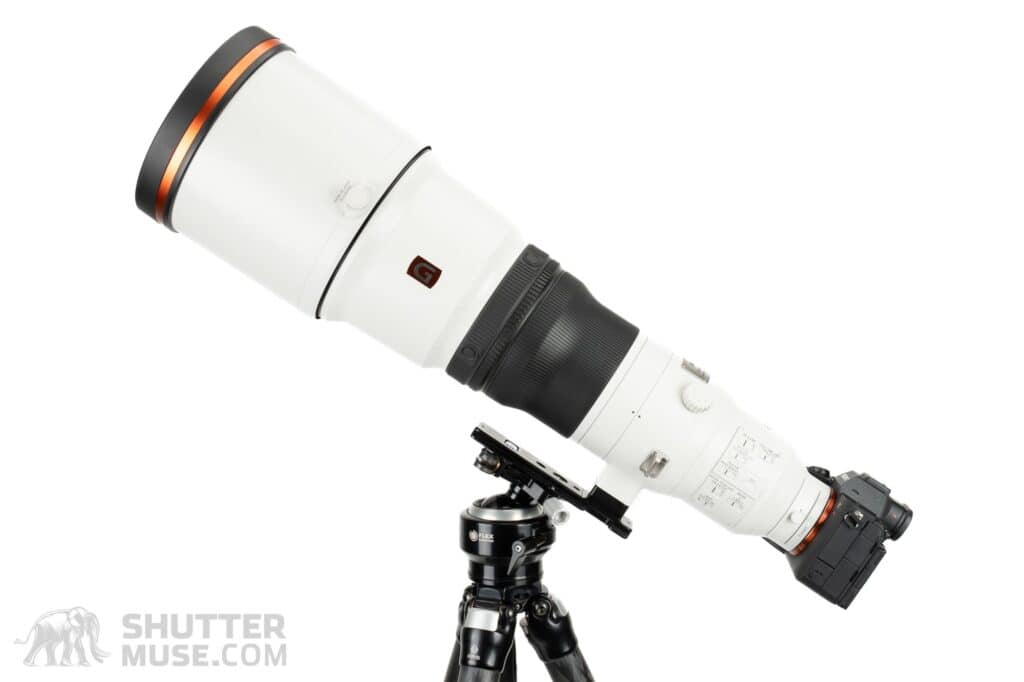










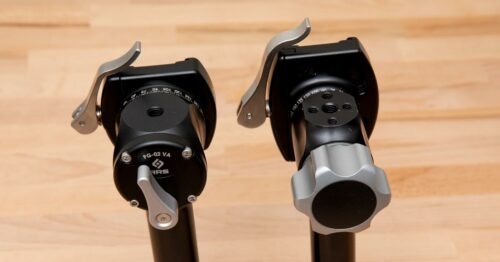
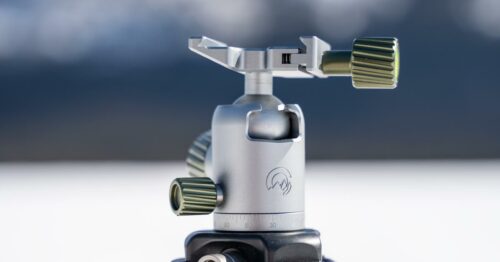
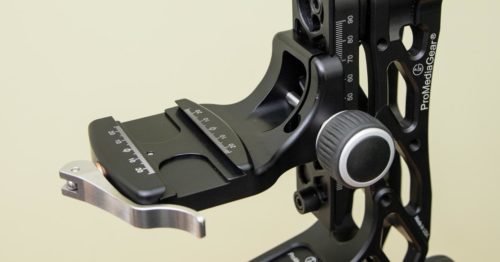

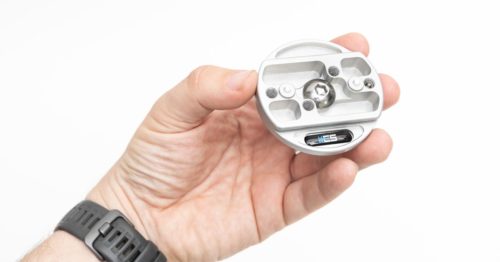
Hi Dan!
I just purchase the flexshooter pro primarily on your recommendation. It is brand new. However, I cannot loosen the black lever for the silver ball by pulling it out and turning nor get the silver ball to move. Is there something wrong with the head? What am I doing wrong? The smaller ball moves just fine. The leveling silver ball and lever seem stiff & stuck.